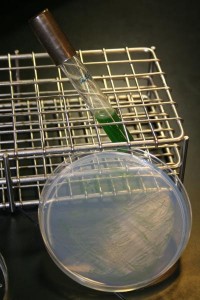Apr
2
Bacteria That Release Oil as They Grow
April 2, 2010 | 1 Comment
Bacteria That Release Oil as They Grow
Xinyao Liu and Professor Roy Curtiss at Arizona State University’s Biodesign Institute have coaxed photosynthetic microbes to secrete oil so bypassing energy and cost barriers that have hampered green biofuel production. The results appeared March 29,2010 in the advanced online issue of the Proceedings of the National Academy of Sciences.
The results are the latest of a series of adaptations pioneered by Liu. The opening was the use of modified thioesterases to cause secretion of fatty acids first described for Escherichia coli by John Cronan of the University of Illinois more than a decade ago. Liu takes off from there. Liu realized that if cyanobacteria could be cajoled into overproducing fatty acids, their accumulation within the cells would eventually cause these fatty acids to leak out through the cell membrane, through the process of diffusion. To accomplish this, Liu introduced a specific enzyme, known as thioesterase, into cyanobacteria.
The enzyme is able to uncouple fatty acids from complex carrier proteins, freeing them within the cell where they accumulate, until the cell secretes them. Liu explains, “I use genes that can steal fatty acids from the lipid synthesis pathway.” The thioesterase acts to efficiently clip the bonds associating the fatty acids with more complex molecules.
A second series of modifications enhances the secretion process, by genetically deleting or modifying two key layers of the cellular envelope known as the S and peptidoglycan layers, thus allowing fatty acids to more easily escape outside the cell, where their low water solubility causes them to precipitate out of solution, forming a whitish residue on the surface that would be available for collection. Study results show a 3-fold increase in fatty acid yield, after genetic modification of the two membrane layers.
To improve the fatty acid production even further, the group working with Liu added genes to cause overproduction of fatty acid precursors and removed some cellular pathways that were non-essential to the survival of cyanobacteria. Such modifications ensure that the microbe’s resources are devoted to basic survival and lipid production.
Liu emphasizes that the current research has moved along at a lightening clip, with only about 6 months passing from the initial work, through production of the first strains. He attributes the facts to the formidable expertise in the area of microbial genetic manipulation of his assisting working group, assembled at the Biodesign Institute. “I don’t think any group would have the capacity to do this as fast,” he said.
Professor Curtiss agrees, noting that “the seminal advance has been to combine a number of genetic modifications and enzyme activities previously described in other bacteria and in plants in the engineered cyanobacteria strains along with the introduction of newly discovered modifications to increase production and secretion of fatty acids. The results to date are encouraging and we are confident of making further improvements to achieve enhanced productivity in strains currently under construction and development. In addition, optimizing growth conditions associated with scale-up will also improve productivity.” These are high potential assertions – especially as the bacteria at issue are photosynthetic.
Professor Curtiss who is director of the Biodesign Institute’s Center for Infectious Diseases and Vaccinology and professor in the School of Life Sciences also said, “By releasing their precious cargo outside the cell, we have optimized bacterial metabolic engineering to develop a truly green route to biofuel production.” Curtiss reminds us, “The real costs involved in any biofuel production are harvesting the fuel precursors and turning them into fuel.” Harvesting is a matter that still bedevils algae research in particular and other pathways to a lesser or greater extent.
Saving the life, be it bacteria or algae is highly worthwhile from a cost and process perspective. Its worth repeating Liu’s quote from the press release. “In China, we have a saying,” Liu says. “We don’t kill the hen to get the eggs.”
The success in this is rather than destroying the cyanobacteria, the group has ingeniously reengineered their genetics, producing mutant strains that continuously secrete fatty acids through their cell walls. The cyanobacteria essentially act like tiny biofuel production facilities.
This is quite a feat all by its self. Now it’s on to scaling up and steps involved to cultivate the organisms. Missing some cell wall as noted might prove a new problem. One way is in hand now. It will be quite something if it gets into mass production. One wonders what other researchers have working.
One senses that some competition is coming. The more the better.
Comments
1 Comment so far



Thank you, I have recently been searching for information about this topic for ages and yours is the best I have discovered so far.